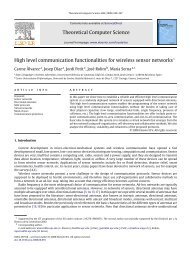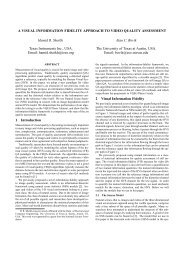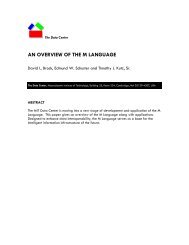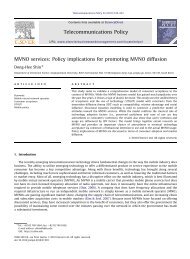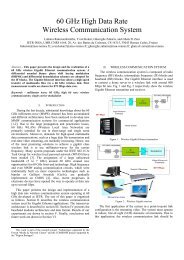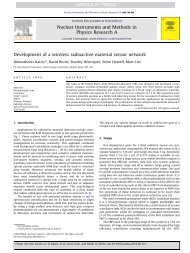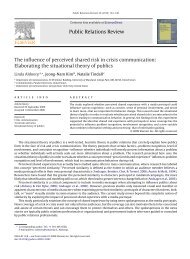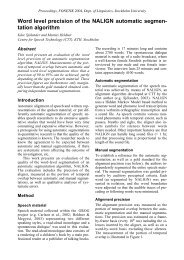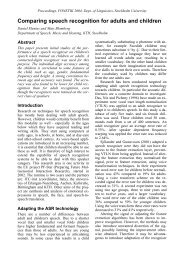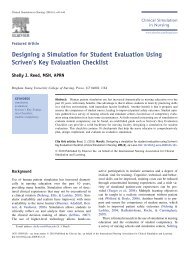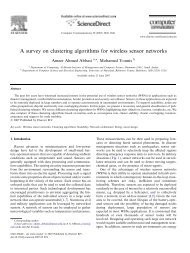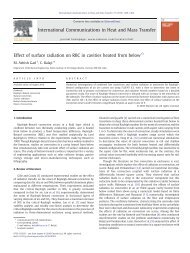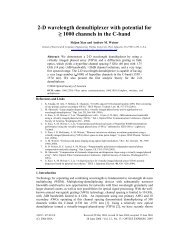Offline handwritten Arabic cursive text recognition using Hidden ...
Offline handwritten Arabic cursive text recognition using Hidden ...
Offline handwritten Arabic cursive text recognition using Hidden ...
Create successful ePaper yourself
Turn your PDF publications into a flip-book with our unique Google optimized e-Paper software.
4.3. Combined scheme for classification <strong>using</strong> HMM and re-ranking<br />
Using the extracted features above, a combined scheme is proposed<br />
for <strong>recognition</strong>, <strong>using</strong> HMM as basic classifier followed by<br />
structure feature based re-ranking. HMM has great potential for<br />
<strong>handwritten</strong> <strong>recognition</strong> (Gunter and Bunke, 2004), especially in<br />
modeling connected nature of <strong>Arabic</strong> <strong>cursive</strong> script (Khorsheed,<br />
2003; El-Hajj et al., 2005; Pechwitz and Maergner, 2003). Basically,<br />
HMM is a finite set of states (N), each of which is associated with a<br />
probability distribution (Rabiner, 1989). Transitions among the<br />
states are governed by a set of probabilities called transition probabilities.<br />
To design such a HMM classifier, several procedures need<br />
to be followed including (i) deciding number of states and observations,<br />
(ii) choosing HMM topology, (iii) model training <strong>using</strong> selected<br />
samples, and (iv) testing and evaluation.<br />
In this paper, we implement our HMM classifier <strong>using</strong> the HMM<br />
Toolkit (HTK), a public available platform for HMM development<br />
which was first used for speech <strong>recognition</strong> (Young et al., 2001).<br />
The simplest but most widely used Bakis topology is employed in<br />
our HMM. An example of such topology with seven states is illustrated<br />
in Fig. 4, allowing state transitions to the same state, the<br />
next state, and the following states only. Such constraints on state<br />
transition are consistent with feature-based observations, as the<br />
later are sequentially extracted from overlapped windows. As a result,<br />
allowing transition to the next two states is useful to incorporate<br />
with potential mis-alignment in segmenting word.<br />
In the training phase, the model is optimized <strong>using</strong> the training<br />
data through an iterative process. The Baum–Welch algorithm, a<br />
variant of the Expectation Maximization (EM) algorithm, is utilized<br />
to maximize the observation sequence probability P(O|k) of the<br />
chosen model k =(p, A, B) for optimization, where parameters A,<br />
B and p, respectively, denote matrix of transition probabilities, matrix<br />
of emission probabilities, and initial states probabilities. For a<br />
training dataset of L observation sequences V = V1, V2, ..., VL, the<br />
optimization aims to adjust model parameters and maximize the<br />
term P(V | k).<br />
In the testing phase, a modified Viterbi algorithm is used for<br />
<strong>recognition</strong>. Given a optimized HMM k =(A, B, p) and an observation<br />
sequence O = o 1, o 2, ..., o N, the observation (feature vector)<br />
is modeled with a mixture of Gaussian. Then, the Viterbi algorithm<br />
is used which searches for the highest model probability of a word<br />
given the input feature vector P(O|k) as<br />
Q ¼ arg max PðOjkÞ: ð4Þ<br />
In our implemented HMM, the first K candidates of highest<br />
probability are attained and denoted as Q ={q1, q2, ..., qK}.<br />
Meanwhile, their associated probability values are denoted as<br />
{p1, p2, ...,pK} where p1 P p2 P , ..., P pK. Instead of taking q1 as<br />
the best recognized result, all candidates in Q are re-ranked<br />
and re-ordered according to their refined probability values<br />
p0 1 ; p0 2 ; ...; p0 K . As a result, the best recognized result(s) will be<br />
the one(s) of maximum refined probability values<br />
qm ¼ arg max<br />
m P0<br />
m : ð5Þ<br />
Structure-like features are used in our re-ranking scheme as follows.<br />
For an observation O, denote its structure features as<br />
{na, nb, nr}. For one candidate class c in Q, its associated probability<br />
pc is refined as<br />
Fig. 4. A 7 state hidden Markov Model (HMM).<br />
J.H AlKhateeb et al. / Pattern Recognition Letters 32 (2011) 1081–1088 1085<br />
p 0<br />
c ¼ p Y<br />
c Rtðnt; cÞ; ð6Þ<br />
t¼a;b;r<br />
Rtðnt; cÞ ¼exp<br />
nt nt;c<br />
rt;c<br />
!<br />
2<br />
; ð7Þ<br />
where R t is a Gaussian-like function for re-ranking and t is the index<br />
of structure features; parameters nt;c and rt,c, respectively, denote<br />
the mean and standard deviation of R t for class c, which are determined<br />
during the training stage <strong>using</strong> all samples that belong to c.<br />
As seen, R t achieves its maximum value of 1 when we have nt ¼ nt;c.<br />
Otherwise, the value decreases as a penalty to pc.<br />
It is worth noting that the above re-ranking scheme is different<br />
from several existing ones such as AL-HAJJ et al., 2009; Prasad et<br />
al., 2010; Saleem et al., 2009. Actually, in the first two systems<br />
above, re-ranking is achieved via fusion of multiple classifiers, such<br />
as three HMMs in the first one and both a SVM classifier and a<br />
HMM classifier used in the second one. In addition, non-visual<br />
information like language model and even acoustic scores are employed<br />
for re-ranking in the last two systems. Our re-ranking<br />
scheme, on the contrary, relies on neither multiple classifiers nor<br />
additional non-visual features yet it produces much improved results<br />
as reported in Section 5. For some important parameters of<br />
the HMM, such as number of states and codebook size, they are<br />
empirically determined and relevant results are also reported<br />
and compared in the next section.<br />
5. Experimental results<br />
In this section, the performance of our system is evaluated,<br />
<strong>using</strong> the well-known IFN/ENIT database. Several experiments<br />
are conducted and compared with numerous typical systems from<br />
others, under the same settings. Relevant results are presented in<br />
details below.<br />
5.1. IFN/ENIT database<br />
Although some work was conducted in <strong>Arabic</strong> <strong>handwritten</strong><br />
words since three decades ago, generally they had small databases<br />
of their own or the presented results on databases which were<br />
unavailable to the public. In addition, real data from banking or<br />
postal mails are either confidential or inaccessible to common user<br />
groups. For performance evaluation of different approaches, a large<br />
and public available dataset is very essential. It is not until 2002<br />
that such a dataset, the IFN/ENIT database (www.ifnenit.com), became<br />
available free for non commercial research (Pechwitz et al.,<br />
2002).<br />
The IFN/ENIT database contains 946 <strong>handwritten</strong> Tunisian<br />
town/village names and their corresponding postcodes. In version<br />
v1.0p2, the database consists of 26,459 <strong>Arabic</strong> names <strong>handwritten</strong><br />
by 411 different people. These names consist of 115,000 pieces of<br />
<strong>Arabic</strong> words (PAW, or subwords) and about 212,000 characters.<br />
In a newer version v2.0p1e, one additional set e containing 6033<br />
names <strong>handwritten</strong> by 87 writers was added, which makes the<br />
whole set to have 32,492 name samples.<br />
All the <strong>handwritten</strong> forms were scanned with 300dpi and converted<br />
to binary images. Each <strong>handwritten</strong> name comes with a binary<br />
image with relevant ground truth. Each ground truth entry<br />
contains the following information: (i) <strong>text</strong> for the image, (ii) postcode,<br />
(iii) character shape sequence, (iv) locations of up to two<br />
baselines, (v) baseline quality, (vi) quantity of words, (vii) quantity<br />
of PAWs, (viii) quantity of characters, and (ix) writing quality.<br />
For training and testing purposes, the whole IFN/ENIT dataset is<br />
partitioned into four subsets (a–d) in v1.0p2 and five subsets (a–e)<br />
in v2.0p1e, respectively, where normally the test set is unknown,



